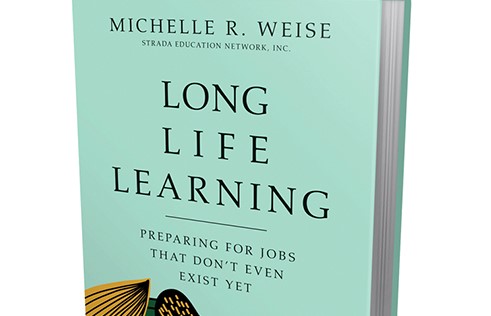It was a year or two after author and professor Clayton Christiansen published his book, Innovative Universities, that I had the good fortune to meet Michelle Weise. We were looking for a speaker to discuss future trends in higher education at our annual strategic planning meeting, and Michelle was recommended.
At the time, she was a senior research fellow at the Clayton Christensen Institute. Since then, she has served as Chief Innovation Officer of the Sandbox Collaborative at Southern New Hampshire University, senior advisor to Entangled Solutions, and SVP Workforce Strategies and Chief Innovation Officer for Strada Education Network. She is presently a senior advisor to BrightHive and Entrepreneur in Residence for Imaginable Futures. Oh, and at one point in time, she was a tenure track assistant professor, specializing in Asian-American literature.
Given Dr. Weise’s background as an English professor, it is not a surprise that the title of her book, Long Life Learning, is a clever play on the more familiar term, Life-Long Learning. At the same time, given her role as an innovator and observer of future trends in the workplace and education, the term is deliberate and, as always, a little ahead of the market.
Long Life Learning is written in two parts. Part I, From a Rigged System, envisions increasing lifespans leading us to a 100-year work-life and asks if a four-year college degree adequately prepares graduates for a lengthy career (note: the 100-year work-life concept is similar to the 60-year curriculum concept that I wrote about in 2019.
Part II, To a New Learning Ecosystem, provides many examples of potential solutions to the “long life learning” requirement of the future. Dr. Weise’s role as an innovator and advisor to many of the companies mentioned provides her with an insider’s perspective. To someone who has embraced and utilized some of these technologies, it’s refreshing to see the advancements of technologies that were embryonic just a few years ago.
Dr. Weise writes that a learning ecosystem like the one that she describes does not exist yet. She recommends that educators and employers work together to develop it and incorporate five guiding principles.
These principles are:
(1) Navigable – people need a bird’s-eye view of the current and future job market, including all of the career pathways open to them based on their interest, skills, past training, and experiences,
(2) Supportive – learners need comprehensive wraparound supports, whether they are person-to-person or tech-enabled, to help them overcome hurdles and manage multiple commitments and competing priorities,
(3) Targeted – learners need access to a precise and relevant education tailored to their needs: the right skills, the right pathways, at the right time,
(4) Integrated – working learners need the time, the funding, the confidence, and the resources to integrate education and training with their existing responsibilities, and
(5) Transparent – the hiring process must be transparent, open, and fair – and enable job seekers to prove their competence and skills.
Dr. Weise writes that the connective tissue that unites these five guiding principles is a more robust data infrastructure, one that shares data among learners, employers, learning providers, funders, and policymakers in any community. Her proposed ecosystem will “teach us the skills of tomorrow and send us smoothly on our way to rinse, wash, repeat – 20 to 30 more times over a lifetime.”
Dr. Weise’s proposed learning ecosystem is generally on target. As someone who has worked with large datasets and data analysis for decades, I believe we need more data analysts, not just in the companies developing the technologies described by Dr. Weise, but also by the universities, training companies, employers, and regulators.
Whether the algorithms utilized by artificial intelligence software are developed by data scientists or machines, data does not always conform to expectations and people who understand the data and the analysis are needed to interpret and rewash the data or rerun the analysis.
The utilization of many of these programs will require the permission of the individual. Individual data privacy has been an issue with the European Union (EU) for years and more recently, the state of California passed similar laws. Companies will have to navigate the regulations and potentially negotiate with policymakers in order to ensure that the shared data does not violate privacy laws or individual rights.
Technology advances continue to accelerate many trends in the workplace and in education. Theoretically, many of the items in Dr. Weise’s proposed ecosystem are available and, with a concerted effort, could be implemented over the next five years. Roadblocks and stumbling blocks will likely lengthen my estimate.
It’s clear to me that there are many educators who will not read Long Life Learning or will consider it too futuristic. That’s too bad because if the handwriting wasn’t on the wall pre-COVID, it’s all over the place now. Most higher education institutions are not preparing their graduates for a 60-year or 100-year working life. As a result, the market will respond, and students will seek other options.
I highly recommend Long Life Learning to all senior leaders in higher education. For those leaders not as familiar with the technology and some of the companies mentioned, I recommend including your institution’s CIO or CTO as a participant in a discussion of the book and Dr. Weise’s recommendations. Ignoring the book, won’t change the momentum.











